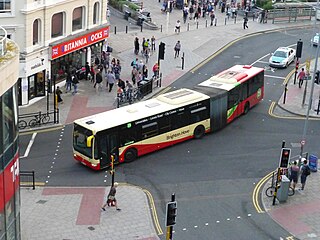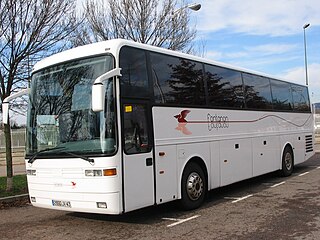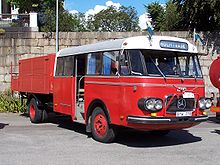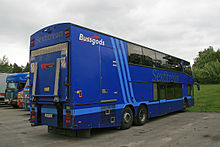
A semi-trailer truck, also known as a semitruck, is the combination of a tractor unit and one or more semi-trailers to carry freight. A semi-trailer attaches to the tractor with a type of hitch called a fifth wheel.

Scania AB is a major Swedish manufacturer headquartered in Södertälje, focusing on commercial vehicles—specifically heavy lorries, trucks and buses. It also manufactures diesel engines for heavy vehicles as well as marine and general industrial applications.

A coach is a bus used for longer-distance service, in contrast to transit buses that are typically used within a single metropolitan region. Often used for touring, intercity, and international bus service, coaches are also used for private charter for various purposes. Coaches are also related and fall under a specific category/type of RVs.

Kenworth Truck Company is an American truck manufacturer. Founded in 1923 as the successor to Gersix Motor Company, Kenworth specializes in production of heavy-duty and medium-duty commercial vehicles. Headquartered in the Seattle suburb of Kirkland, Washington, Kenworth has been a wholly owned subsidiary of PACCAR since 1945, operating alongside sister company Peterbilt Motors.

An articulated bus, also referred to as a banana bus, bendy bus, tandem bus, vestibule bus, wiggle wagon, stretch bus, or an accordion bus, is an articulated vehicle used in public transportation. It is usually a single-decker, and comprises two or more rigid sections linked by a pivoting joint (articulation) enclosed by protective bellows inside and outside and a cover plate on the floor. This allows a longer legal length than rigid-bodied buses, and hence a higher passenger capacity (94–120), while still allowing the bus to maneuver adequately.

A low-floor bus is a bus or trolleybus that has no steps between the ground and the floor of the bus at one or more entrances, and low floor for part or all of the passenger cabin. A bus with a partial low floor may also be referred to as a low-entry bus or seldom a flat-floor bus in some locations.

Van Hool NV is a Belgian family-owned coachbuilder and manufacturer of buses, coaches, trolleybuses, and trailers.

The Volvo B12BLE is a low-entry city and suburban bus chassis launched in 2001 with a rear-mounted transverse engine. It superseded the Volvo B10BLE and is used as a base for single-decker buses in Europe and Australia.

The Volvo Ailsa B55 was a front-engined double-decker bus chassis manufactured in Scotland by Ailsa, Volvo's British subsidiary in which it owned 75%, from 1974 until 1985.

The Volvo B10M was a mid-engined city bus and coach chassis manufactured by Volvo between 1978 and 2003. It succeeded the B58 and was equipped with the same 9.6-litre horizontally mounted Volvo diesel engine mounted under the floor behind the front axle. An articulated version under the model name Volvo B10MA was also offered, as was a semi-integral version known as the C10M, with the engine in the middle of the chassis.

The Leyland Atlantean is a predominantly double-decker bus chassis manufactured by Leyland Motors between 1958 and 1986. Only 17 Atlantean chassis were bodied as single deck from new.

A bi-articulated bus or double-articulated bus and sometimes train-bus is a type of high-capacity articulated bus with an extra axle and a second articulation joint, as well as extended length. Bi-articulated buses tend to be employed in high-frequency core routes or bus rapid transit schemes rather than in conventional bus routes.

An articulated hauler, articulated dump truck (ADT), or sometimes a dump hauler, is a very large heavy-duty type of dump truck used to transport loads over rough terrain, and occasionally on public roads. The vehicle usually has all-wheel drive and consists of two basic units: the front section, generally called the tractor, and the rear section that contains the dump body, called the hauler or trailer section. Steering is made by pivoting the front in relation to the back by hydraulic rams. This way, all wheels follow the same path, making it an excellent off-road vehicle.

A multi-axle bus is a bus or coach that has more than the conventional two axles, usually three, or more rarely, four. Extra axles are usually added for legal weight restriction reasons, or to accommodate different vehicle designs such as articulation, or rarely, to implement trailer buses.

Bus manufacturing, a sector of the automotive industry, manufactures buses and coaches.

The Albion Nimbus was an underfloor-engined, ultra-lightweight midibus or coach chassis, with a four-cylinder horizontal diesel engine and a gross vehicle weight of six tons. It was largely operated on light rural bus duties and private hires. Operators who used it on heavy-duty bus routes found it insufficiently robust. It was the first Albion bus chassis to have a name that did not begin with the letter V. The design was revised twice and was produced from 1955 to 1965.

LAG Motorcoach was the North American subsidiary of LAG Manufacturing Company, of Bree, Belgium.

The Leyland Royal Tiger Worldmaster, sometimes simply known as the Leyland Worldmaster, was a mid-underfloor-engined single-decker bus or single-decker coach chassis manufactured by Leyland between 1954 and 1979.

The Volvo 9700 is a range of coaches manufactured by Volvo. It was introduced in 2001 as a replacement for the Carrus Star and Vector/Regal models. There are three main models in different heights; 9700S, 9700H and 9700HD. The 9700S is only available in the Nordic countries. In addition there is the stripped down 9500 and the 9900 with theater seating. The coaches come in a variety of lengths up to 15 metres, depending on models and markets. Volvo 9700 is currently sold in most of Europe and North America. In 2015, the Volvo 9800 was launched as a replacement for the Mexican market, followed by the double-decker 9800DD in March 2018.

The Volvo 8900 is a single-decker city bus and intercity bus, first introduced in 2010 as a cross-breed successor to both the aluminium body 8500 and the stainless steel body 8700, taking advantage of both techniques. It is available both with 860 mm step-entrance floor and as the low-entry Volvo 8900LE.































